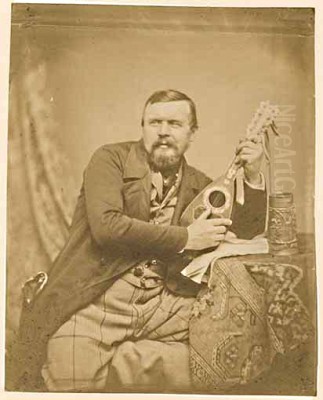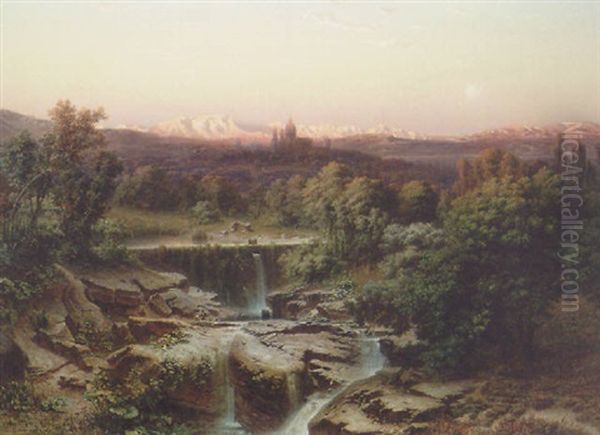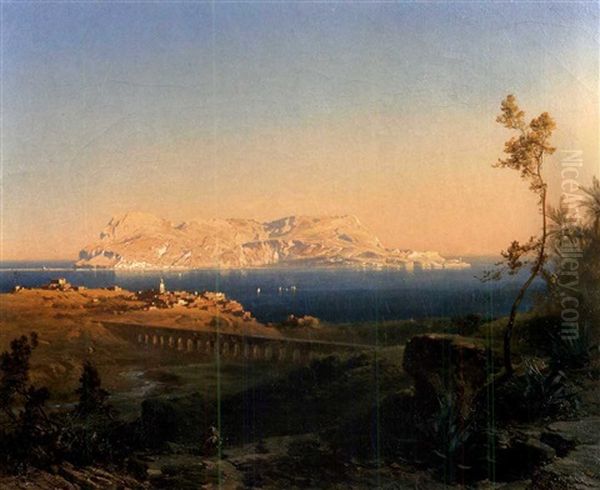
Fritz Bamberger stands as a significant, if sometimes overlooked, figure in 19th-century German art. A dedicated landscape painter, he carved a unique niche for himself by bringing the sun-drenched vistas and historic cityscapes of Spain to the attention of a Northern European audience. His work, deeply rooted in the Romantic tradition, combined meticulous observation with a profound appreciation for atmosphere and light, leaving behind a legacy of evocative paintings that continue to captivate.
Early Life and Artistic Awakening in Germany
Born on October 17, 1814, in Würzburg, a historic city in the Franconia region of Bavaria, Friedrich "Fritz" Bamberger hailed from a family with strong artistic inclinations, though primarily in music. He was one of four brothers, and his parents were both musicians; his mother later distinguished herself as an opera singer. This creative household environment likely nurtured his own artistic sensibilities from a young age, even if his path would lead to the visual rather than auditory arts.
Bamberger's formal artistic training began not in his native Bavaria but in the Prussian capital. He enrolled at the prestigious Berlin Art Academy, where he studied under the guidance of Johann Gottfried Schadow, a leading Neoclassical sculptor and painter, and director of the Academy. Schadow's influence, though perhaps more classical, would have provided a strong foundation in drawing and composition. Following his time at the Academy, Bamberger further honed his skills in the private studio of Wilhelm Krause (often cited as W. Kauser), a notable marine and landscape painter. This tutelage under Krause was likely instrumental in steering Bamberger towards landscape painting, particularly scenes involving water and expansive skies.
Formative Years and the Influence of Munich
The early 1830s marked a period of movement and continued learning for the young artist. In 1830, Bamberger relocated to Kassel, where he benefited from the instruction of Georg Primavesi, who held the position of court painter. This experience would have exposed him to different artistic currents and potentially the demands of aristocratic patronage.

However, a more decisive shift in his artistic focus occurred after his move to Munich in 1831. The Bavarian capital was a vibrant artistic hub, and it was here that Bamberger encountered the work and, significantly, the influence of Carl Rottmann. Rottmann was a preeminent figure in German Romantic landscape painting, celebrated for his monumental cycles of Greek and Italian landscapes, which masterfully combined topographical accuracy with a powerful, almost heroic, sense of atmosphere. Under Rottmann's sway, Bamberger solidified his commitment to landscape painting, absorbing the Romantic emphasis on nature's grandeur and emotional resonance. He continued his studies at the Munich Art Academy, further refining his technique and vision. He also maintained connections with his hometown, returning to Würzburg to continue painting before further studies.
The Lure of Spain: A Defining Passion
While his German training provided a solid foundation, it was the Iberian Peninsula that would truly define Bamberger's artistic identity. He developed a profound fascination with Spain – its diverse landscapes, unique light, and rich history. His first journey to Spain took place in the 1840s, and it proved to be a transformative experience. He would return multiple times throughout his career, drawn to the varied terrains of Castile, the sun-baked plains of Andalusia, and the coastal beauty of Valencia.
Bamberger dedicated much of his artistic output to capturing the essence of Spain. He painted panoramic views of major cities, including Madrid, Toledo with its ancient architecture, the vibrant Seville, and the coastal city of Barcelona. These were not mere topographical records; Bamberger imbued them with a Romantic sensibility, emphasizing dramatic light, atmospheric effects, and a sense of timelessness. His Spanish landscapes were highly sought after, particularly by European aristocrats and collectors who were captivated by these exotic and picturesque scenes from a land that, for many, remained remote and mysterious.
Artistic Style: Romanticism and Meticulous Detail
Fritz Bamberger's artistic style is firmly situated within the German Romantic movement, yet it possesses its own distinct characteristics. Like many Romantics, he sought to convey not just the physical appearance of a landscape but also its emotional impact and inherent spirit. His works often feature a careful balance between the sublime aspects of nature – expansive skies, distant mountain ranges, the vastness of the sea – and the picturesque details of human presence, such as historic architecture or small figures that provide scale and narrative interest.

A hallmark of his style was the meticulous attention to detail, evident in the rendering of foliage, rock formations, and architectural elements. This precision, however, did not result in a dry, academic manner. Instead, it was combined with a sophisticated understanding of light and color. Bamberger was particularly adept at capturing the clear, strong light of Spain, the hazy atmosphere of a coastal morning, or the warm glow of a Mediterranean sunset. His palette was rich and nuanced, capable of conveying both the vibrant hues of a sunny landscape and the subtle gradations of a more somber scene. His compositions were carefully constructed, often leading the viewer's eye through a series of planes to a distant, evocative horizon.
Key Works and Recognition
Several works stand out in Fritz Bamberger's oeuvre, showcasing his skill and thematic preoccupations. An early piece that garnered significant attention was The Battle of Hastings with a View of the Sea, reportedly painted around 1837. This historical landscape demonstrated his ambition and his ability to handle complex compositions involving numerous figures and dramatic natural settings, a theme also explored by contemporaries like the French Romantic Eugène Delacroix in historical scenes, or the dramatic sea battles painted by artists like Clarkson Stanfield in Britain.
However, it is his Spanish and Mediterranean scenes that form the core of his legacy. Works such as Puente de la Tagus at Madrid (Bridge of the Tagus at Madrid) and views of the Sierra de Guadarrama exemplify his dedication to capturing the specific character of the Spanish landscape. Another significant painting is Blick auf die Bucht von Nissa (View of the Bay of Nissa), with "Nissa" likely referring to Nice on the French Riviera, indicating his interest extended to other Mediterranean locales. These paintings, along with others like Moroccan Harbor and views of Algeciras, highlight his fascination with coastal environments and the interplay of land, sea, and light.
His talent did not go unnoticed. His paintings were popular among European nobility and found their way into important private collections. The precision and evocative beauty of his landscapes appealed to the tastes of the time, which valued both topographical accuracy and romantic sentiment.
Royal Connections and Teaching
Bamberger's reputation extended to royal circles. He had the honor of serving as a drawing and painting instructor to Princess Amalia de Borbón (Infanta Amalia Filipina of Spain), a member of the Spanish royal family. This position not only provided him with patronage but also placed him in close proximity to the cultural elite of Spain. It is recorded that he painted several portraits for the princess and was even commissioned to create a portrait of Queen Isabella II of Spain as a gift for Princess Amalia. This aspect of his career, while secondary to his landscape work, underscores the esteem in which he was held.
Interruption and Continued Dedication
Bamberger's artistic career experienced an interruption between approximately 1837 and 1840, during which he fulfilled a three-year period of military service in Würzburg. This hiatus, occurring relatively early in his professional life, might have delayed some of his artistic projects but did not dampen his ultimate commitment to painting. Following his service, he returned to Munich, a city that remained a key base for him, and increasingly focused his energies on landscape painting, particularly the Spanish subjects that had so captivated him.
During his time in Paris, he developed a close relationship with Graf Adolf Friedrich von Schack, a significant German poet, art historian, and collector. Schack was a major patron of Munich-based artists, including Arnold Böcklin, Franz von Lenbach, and Anselm Feuerbach, and his collection, the Schackgalerie (now part of the Bavarian State Painting Collections), became a repository of important 19th-century German art. Bamberger's association with Schack would have provided him with support and further integrated him into influential artistic circles. While in Spain, he also reportedly collaborated with fellow artists such as Franz von Lenbach, who would become one of Germany's foremost portrait painters, and Emil Brandes.
The Broader Artistic Milieu
Fritz Bamberger worked during a dynamic period in European art. Romanticism, which had its roots in the late 18th century with figures like Caspar David Friedrich in Germany and J.M.W. Turner and John Constable in England, continued to be a dominant force through the first half of the 19th century. Bamberger's detailed yet atmospheric landscapes align well with the later phases of this movement. His focus on specific, identifiable locations, rendered with care, also shows an affinity with the growing trend towards Realism, though his work never fully shed its Romantic sensibility.
In Germany, the art scene was vibrant. The Düsseldorf School, with artists like Andreas Achenbach and Oswald Achenbach (known for their dramatic landscapes, often including Italian scenes), was highly influential. The Munich School, to which Bamberger was more closely aligned through Rottmann, also had its distinct character, often emphasizing a more painterly approach and, in Rottmann's case, monumental historical landscapes. Other German contemporaries included landscape painters like Carl Blechen, whose work bridged Romanticism and an early form of Realism, and figures from the Biedermeier period such as Ludwig Richter and Moritz von Schwind, who often depicted more idyllic and narrative scenes.
Bamberger's specialization in Spanish landscapes set him apart. While Italy had long been a primary destination for Northern European artists (like Jakob Philipp Hackert before him, or the Achenbach brothers contemporaneously), Spain was less frequently depicted with such dedication. In this, he shared some common ground with Spanish Romantic landscapists like Jenaro Pérez Villaamil, who was instrumental in popularizing Spanish landscapes within Spain itself. David Roberts, a Scottish painter, also famously traveled and painted extensively in Spain around the same period, bringing its picturesque qualities to a British audience.
Later Years and Lasting Legacy
Despite his successes, Fritz Bamberger's later life was marked by declining health. He continued to paint, but his physical ailments eventually took their toll. He passed away on August 13, 1873, in Neuenhain, a village near Bad Soden in the Taunus mountains, not far from Frankfurt am Main. He was 58 years old.
Fritz Bamberger left behind a significant body of work that documents not only the landscapes he loved but also the artistic sensibilities of his time. His paintings are valued for their technical skill, their evocative portrayal of Spain and the Mediterranean, and their contribution to the German Romantic landscape tradition. His works can be found in various museums and private collections, including the Neue Pinakothek in Munich and reportedly the Musée d'Orsay in Paris, attesting to his international recognition. He is remembered as a dedicated artist who successfully merged German Romantic ideals with a deep and personal engagement with the landscapes of Southern Europe, particularly Spain, offering a unique window onto these regions for his contemporaries and for posterity. His role as a professor, though less detailed in historical records, also suggests a commitment to passing on artistic knowledge.
Conclusion
Fritz Bamberger's career charts a fascinating journey from a musically-inclined family in Würzburg through the major art academies and influences of Germany to a profound and career-defining engagement with the landscapes of Spain. As an artist of the Romantic era, he skillfully balanced detailed observation with an expressive rendering of light and atmosphere, creating works that resonated with the tastes of his time and continue to be appreciated for their beauty and historical value. By focusing much of his attention on Spain, he not only distinguished himself among his German contemporaries but also played a crucial role in broadening the visual horizons of 19th-century European art, bringing the unique character of the Iberian Peninsula to a wider audience. His legacy is that of a meticulous craftsman and a sensitive interpreter of nature, a German Romantic with a distinctly Spanish heart.